Comprehensive Literature Review: Dementia, Diagnosis, and Technology
VerifiedAdded on 2023/01/13
|8
|2147
|40
Literature Review
AI Summary
This literature review examines the health disorder of dementia, focusing on its characteristics, diagnosis, and the impact of cognitive decline. The review analyzes various research papers to understand the issue of dementia and demonstrate the people diagnosed with the disorder. It explores the technologies used by specialists for controlling and managing the functions of the human body system, including assistive technologies, automated prompts, reminder devices, and communication aids. The review highlights the increasing rate of dementia, the risk factors associated with it, and the potential of technology to improve the lives of patients. It discusses the use of sensors, AI technology, context awareness devices, and other technological advancements designed to support patients and their families. The review references key studies and identifies the importance of these technologies in managing the challenges of dementia.

Dementia
Paraphrase This Document
Need a fresh take? Get an instant paraphrase of this document with our AI Paraphraser
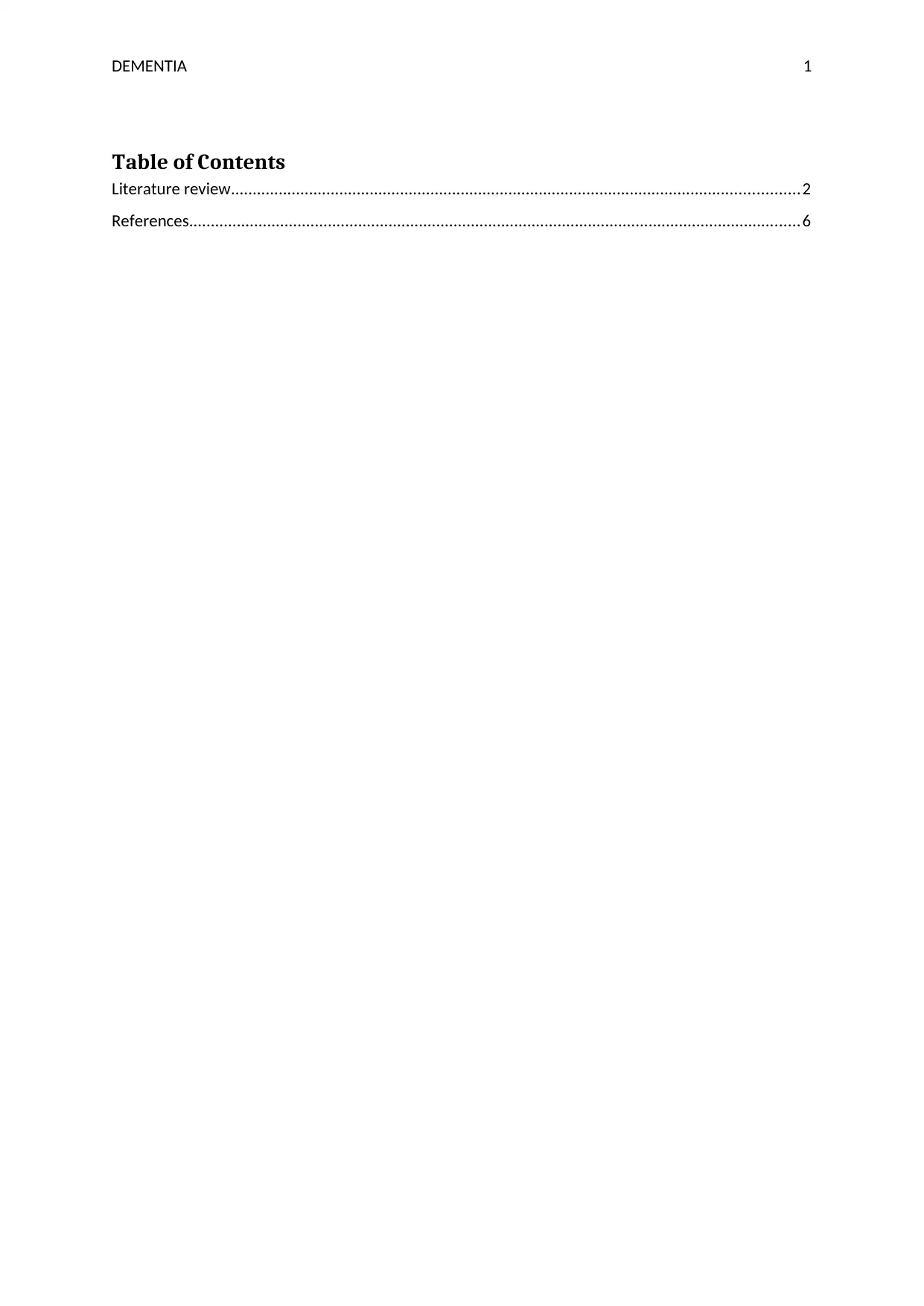
DEMENTIA 1
Table of Contents
Literature review...................................................................................................................................2
References.............................................................................................................................................6
Table of Contents
Literature review...................................................................................................................................2
References.............................................................................................................................................6
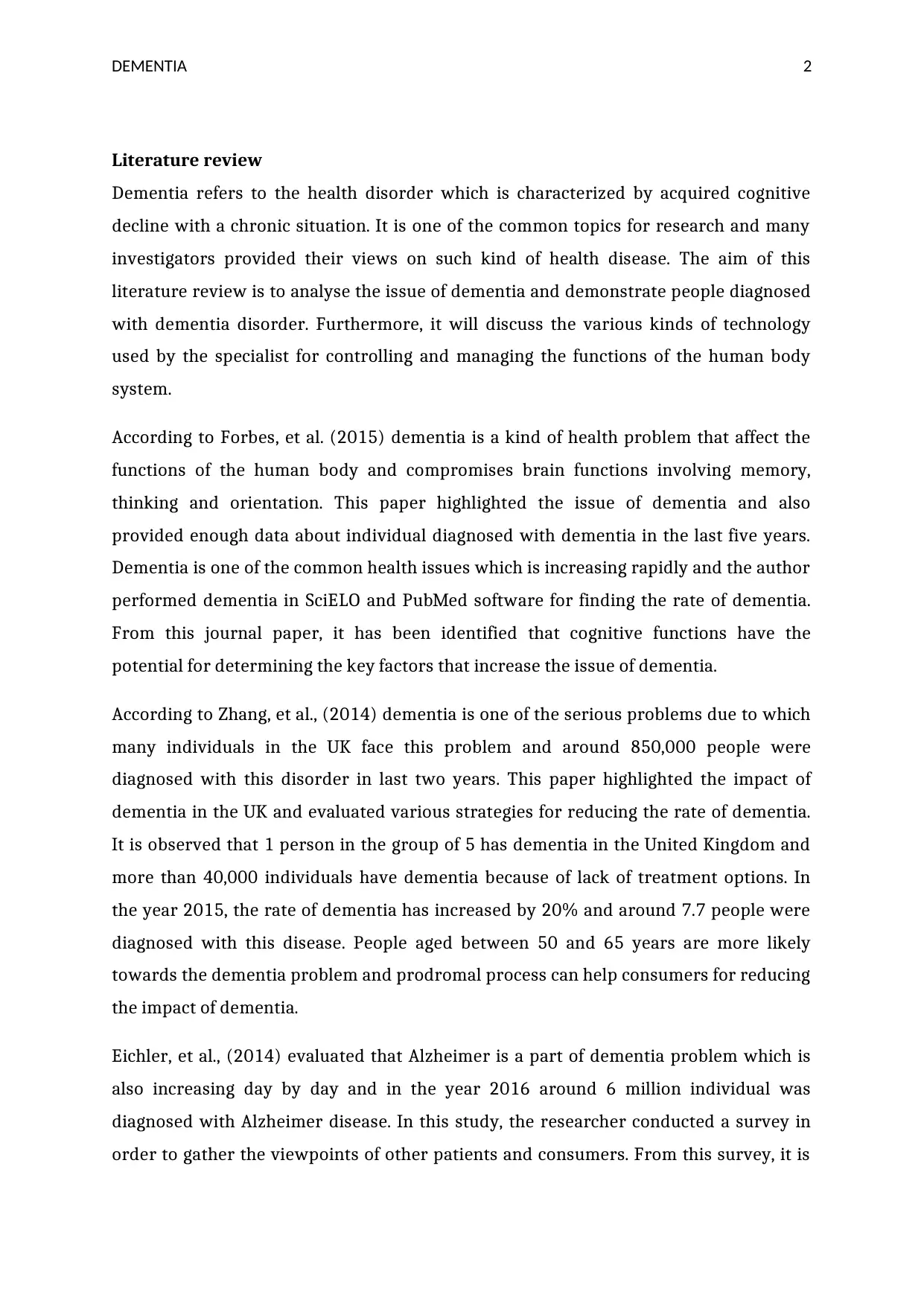
DEMENTIA 2
Literature review
Dementia refers to the health disorder which is characterized by acquired cognitive
decline with a chronic situation. It is one of the common topics for research and many
investigators provided their views on such kind of health disease. The aim of this
literature review is to analyse the issue of dementia and demonstrate people diagnosed
with dementia disorder. Furthermore, it will discuss the various kinds of technology
used by the specialist for controlling and managing the functions of the human body
system.
According to Forbes, et al. (2015) dementia is a kind of health problem that affect the
functions of the human body and compromises brain functions involving memory,
thinking and orientation. This paper highlighted the issue of dementia and also
provided enough data about individual diagnosed with dementia in the last five years.
Dementia is one of the common health issues which is increasing rapidly and the author
performed dementia in SciELO and PubMed software for finding the rate of dementia.
From this journal paper, it has been identified that cognitive functions have the
potential for determining the key factors that increase the issue of dementia.
According to Zhang, et al., (2014) dementia is one of the serious problems due to which
many individuals in the UK face this problem and around 850,000 people were
diagnosed with this disorder in last two years. This paper highlighted the impact of
dementia in the UK and evaluated various strategies for reducing the rate of dementia.
It is observed that 1 person in the group of 5 has dementia in the United Kingdom and
more than 40,000 individuals have dementia because of lack of treatment options. In
the year 2015, the rate of dementia has increased by 20% and around 7.7 people were
diagnosed with this disease. People aged between 50 and 65 years are more likely
towards the dementia problem and prodromal process can help consumers for reducing
the impact of dementia.
Eichler, et al., (2014) evaluated that Alzheimer is a part of dementia problem which is
also increasing day by day and in the year 2016 around 6 million individual was
diagnosed with Alzheimer disease. In this study, the researcher conducted a survey in
order to gather the viewpoints of other patients and consumers. From this survey, it is
Literature review
Dementia refers to the health disorder which is characterized by acquired cognitive
decline with a chronic situation. It is one of the common topics for research and many
investigators provided their views on such kind of health disease. The aim of this
literature review is to analyse the issue of dementia and demonstrate people diagnosed
with dementia disorder. Furthermore, it will discuss the various kinds of technology
used by the specialist for controlling and managing the functions of the human body
system.
According to Forbes, et al. (2015) dementia is a kind of health problem that affect the
functions of the human body and compromises brain functions involving memory,
thinking and orientation. This paper highlighted the issue of dementia and also
provided enough data about individual diagnosed with dementia in the last five years.
Dementia is one of the common health issues which is increasing rapidly and the author
performed dementia in SciELO and PubMed software for finding the rate of dementia.
From this journal paper, it has been identified that cognitive functions have the
potential for determining the key factors that increase the issue of dementia.
According to Zhang, et al., (2014) dementia is one of the serious problems due to which
many individuals in the UK face this problem and around 850,000 people were
diagnosed with this disorder in last two years. This paper highlighted the impact of
dementia in the UK and evaluated various strategies for reducing the rate of dementia.
It is observed that 1 person in the group of 5 has dementia in the United Kingdom and
more than 40,000 individuals have dementia because of lack of treatment options. In
the year 2015, the rate of dementia has increased by 20% and around 7.7 people were
diagnosed with this disease. People aged between 50 and 65 years are more likely
towards the dementia problem and prodromal process can help consumers for reducing
the impact of dementia.
Eichler, et al., (2014) evaluated that Alzheimer is a part of dementia problem which is
also increasing day by day and in the year 2016 around 6 million individual was
diagnosed with Alzheimer disease. In this study, the researcher conducted a survey in
order to gather the viewpoints of other patients and consumers. From this survey, it is
⊘ This is a preview!⊘
Do you want full access?
Subscribe today to unlock all pages.

Trusted by 1+ million students worldwide
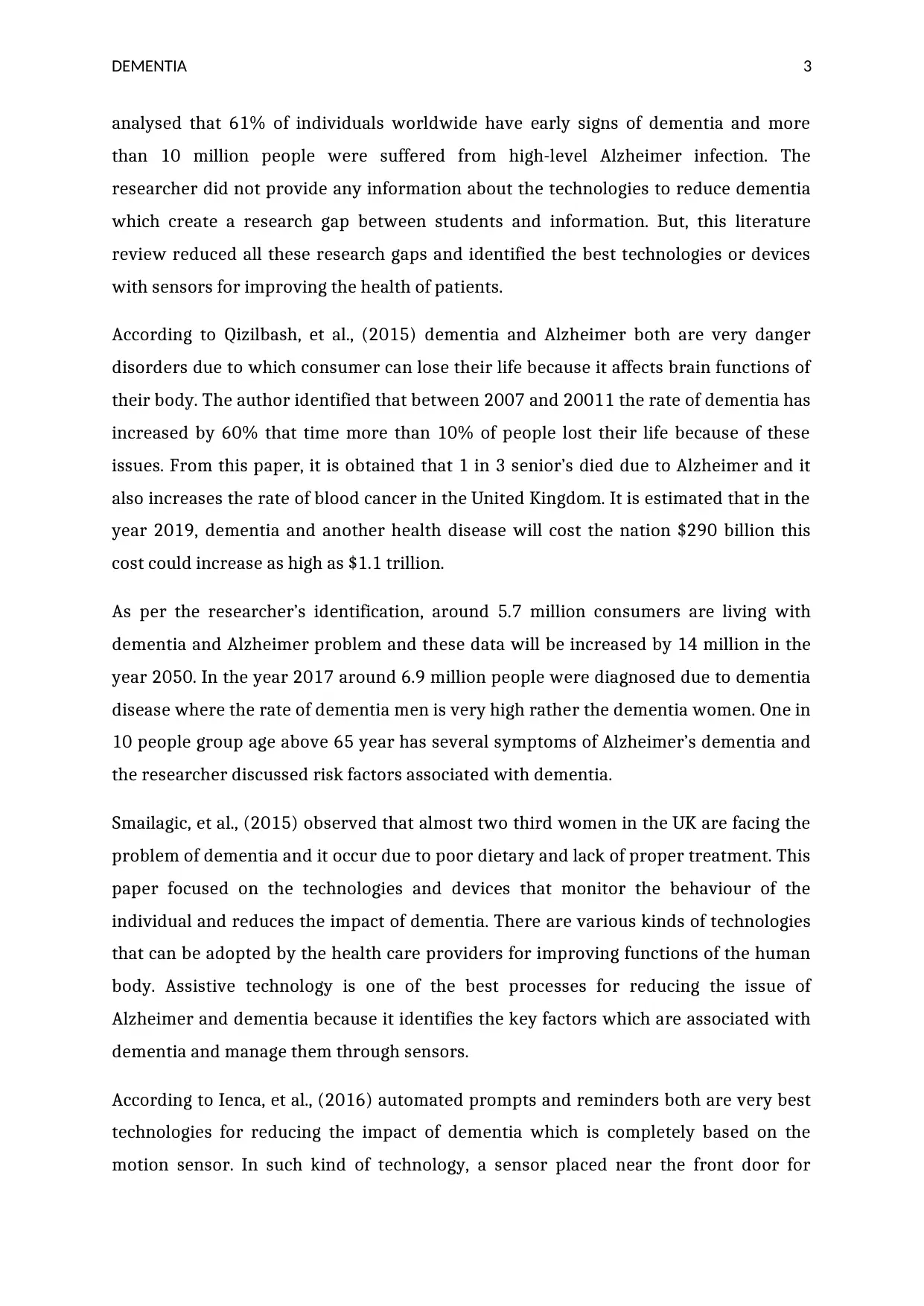
DEMENTIA 3
analysed that 61% of individuals worldwide have early signs of dementia and more
than 10 million people were suffered from high-level Alzheimer infection. The
researcher did not provide any information about the technologies to reduce dementia
which create a research gap between students and information. But, this literature
review reduced all these research gaps and identified the best technologies or devices
with sensors for improving the health of patients.
According to Qizilbash, et al., (2015) dementia and Alzheimer both are very danger
disorders due to which consumer can lose their life because it affects brain functions of
their body. The author identified that between 2007 and 20011 the rate of dementia has
increased by 60% that time more than 10% of people lost their life because of these
issues. From this paper, it is obtained that 1 in 3 senior’s died due to Alzheimer and it
also increases the rate of blood cancer in the United Kingdom. It is estimated that in the
year 2019, dementia and another health disease will cost the nation $290 billion this
cost could increase as high as $1.1 trillion.
As per the researcher’s identification, around 5.7 million consumers are living with
dementia and Alzheimer problem and these data will be increased by 14 million in the
year 2050. In the year 2017 around 6.9 million people were diagnosed due to dementia
disease where the rate of dementia men is very high rather the dementia women. One in
10 people group age above 65 year has several symptoms of Alzheimer’s dementia and
the researcher discussed risk factors associated with dementia.
Smailagic, et al., (2015) observed that almost two third women in the UK are facing the
problem of dementia and it occur due to poor dietary and lack of proper treatment. This
paper focused on the technologies and devices that monitor the behaviour of the
individual and reduces the impact of dementia. There are various kinds of technologies
that can be adopted by the health care providers for improving functions of the human
body. Assistive technology is one of the best processes for reducing the issue of
Alzheimer and dementia because it identifies the key factors which are associated with
dementia and manage them through sensors.
According to Ienca, et al., (2016) automated prompts and reminders both are very best
technologies for reducing the impact of dementia which is completely based on the
motion sensor. In such kind of technology, a sensor placed near the front door for
analysed that 61% of individuals worldwide have early signs of dementia and more
than 10 million people were suffered from high-level Alzheimer infection. The
researcher did not provide any information about the technologies to reduce dementia
which create a research gap between students and information. But, this literature
review reduced all these research gaps and identified the best technologies or devices
with sensors for improving the health of patients.
According to Qizilbash, et al., (2015) dementia and Alzheimer both are very danger
disorders due to which consumer can lose their life because it affects brain functions of
their body. The author identified that between 2007 and 20011 the rate of dementia has
increased by 60% that time more than 10% of people lost their life because of these
issues. From this paper, it is obtained that 1 in 3 senior’s died due to Alzheimer and it
also increases the rate of blood cancer in the United Kingdom. It is estimated that in the
year 2019, dementia and another health disease will cost the nation $290 billion this
cost could increase as high as $1.1 trillion.
As per the researcher’s identification, around 5.7 million consumers are living with
dementia and Alzheimer problem and these data will be increased by 14 million in the
year 2050. In the year 2017 around 6.9 million people were diagnosed due to dementia
disease where the rate of dementia men is very high rather the dementia women. One in
10 people group age above 65 year has several symptoms of Alzheimer’s dementia and
the researcher discussed risk factors associated with dementia.
Smailagic, et al., (2015) observed that almost two third women in the UK are facing the
problem of dementia and it occur due to poor dietary and lack of proper treatment. This
paper focused on the technologies and devices that monitor the behaviour of the
individual and reduces the impact of dementia. There are various kinds of technologies
that can be adopted by the health care providers for improving functions of the human
body. Assistive technology is one of the best processes for reducing the issue of
Alzheimer and dementia because it identifies the key factors which are associated with
dementia and manage them through sensors.
According to Ienca, et al., (2016) automated prompts and reminders both are very best
technologies for reducing the impact of dementia which is completely based on the
motion sensor. In such kind of technology, a sensor placed near the front door for
Paraphrase This Document
Need a fresh take? Get an instant paraphrase of this document with our AI Paraphraser
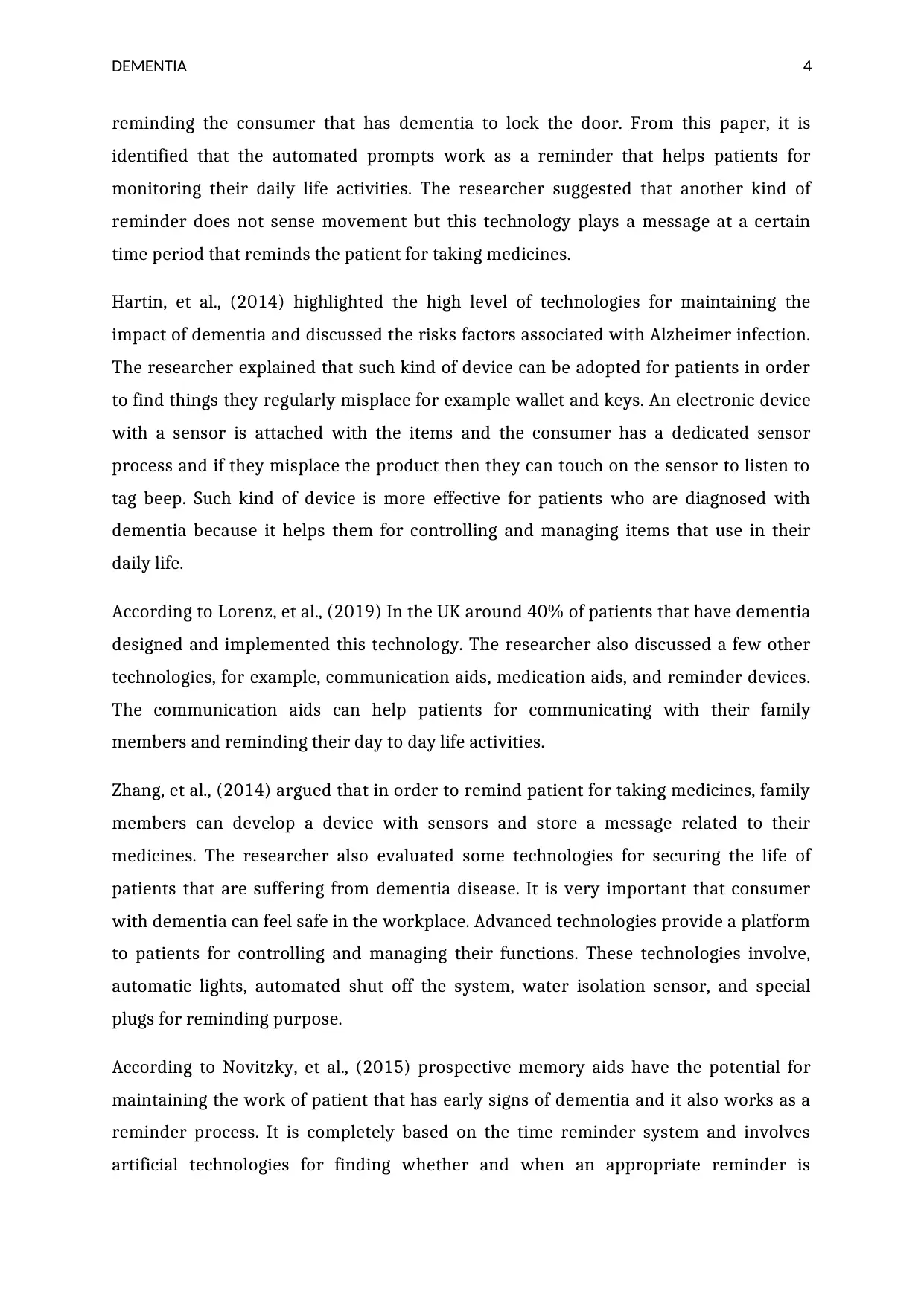
DEMENTIA 4
reminding the consumer that has dementia to lock the door. From this paper, it is
identified that the automated prompts work as a reminder that helps patients for
monitoring their daily life activities. The researcher suggested that another kind of
reminder does not sense movement but this technology plays a message at a certain
time period that reminds the patient for taking medicines.
Hartin, et al., (2014) highlighted the high level of technologies for maintaining the
impact of dementia and discussed the risks factors associated with Alzheimer infection.
The researcher explained that such kind of device can be adopted for patients in order
to find things they regularly misplace for example wallet and keys. An electronic device
with a sensor is attached with the items and the consumer has a dedicated sensor
process and if they misplace the product then they can touch on the sensor to listen to
tag beep. Such kind of device is more effective for patients who are diagnosed with
dementia because it helps them for controlling and managing items that use in their
daily life.
According to Lorenz, et al., (2019) In the UK around 40% of patients that have dementia
designed and implemented this technology. The researcher also discussed a few other
technologies, for example, communication aids, medication aids, and reminder devices.
The communication aids can help patients for communicating with their family
members and reminding their day to day life activities.
Zhang, et al., (2014) argued that in order to remind patient for taking medicines, family
members can develop a device with sensors and store a message related to their
medicines. The researcher also evaluated some technologies for securing the life of
patients that are suffering from dementia disease. It is very important that consumer
with dementia can feel safe in the workplace. Advanced technologies provide a platform
to patients for controlling and managing their functions. These technologies involve,
automatic lights, automated shut off the system, water isolation sensor, and special
plugs for reminding purpose.
According to Novitzky, et al., (2015) prospective memory aids have the potential for
maintaining the work of patient that has early signs of dementia and it also works as a
reminder process. It is completely based on the time reminder system and involves
artificial technologies for finding whether and when an appropriate reminder is
reminding the consumer that has dementia to lock the door. From this paper, it is
identified that the automated prompts work as a reminder that helps patients for
monitoring their daily life activities. The researcher suggested that another kind of
reminder does not sense movement but this technology plays a message at a certain
time period that reminds the patient for taking medicines.
Hartin, et al., (2014) highlighted the high level of technologies for maintaining the
impact of dementia and discussed the risks factors associated with Alzheimer infection.
The researcher explained that such kind of device can be adopted for patients in order
to find things they regularly misplace for example wallet and keys. An electronic device
with a sensor is attached with the items and the consumer has a dedicated sensor
process and if they misplace the product then they can touch on the sensor to listen to
tag beep. Such kind of device is more effective for patients who are diagnosed with
dementia because it helps them for controlling and managing items that use in their
daily life.
According to Lorenz, et al., (2019) In the UK around 40% of patients that have dementia
designed and implemented this technology. The researcher also discussed a few other
technologies, for example, communication aids, medication aids, and reminder devices.
The communication aids can help patients for communicating with their family
members and reminding their day to day life activities.
Zhang, et al., (2014) argued that in order to remind patient for taking medicines, family
members can develop a device with sensors and store a message related to their
medicines. The researcher also evaluated some technologies for securing the life of
patients that are suffering from dementia disease. It is very important that consumer
with dementia can feel safe in the workplace. Advanced technologies provide a platform
to patients for controlling and managing their functions. These technologies involve,
automatic lights, automated shut off the system, water isolation sensor, and special
plugs for reminding purpose.
According to Novitzky, et al., (2015) prospective memory aids have the potential for
maintaining the work of patient that has early signs of dementia and it also works as a
reminder process. It is completely based on the time reminder system and involves
artificial technologies for finding whether and when an appropriate reminder is
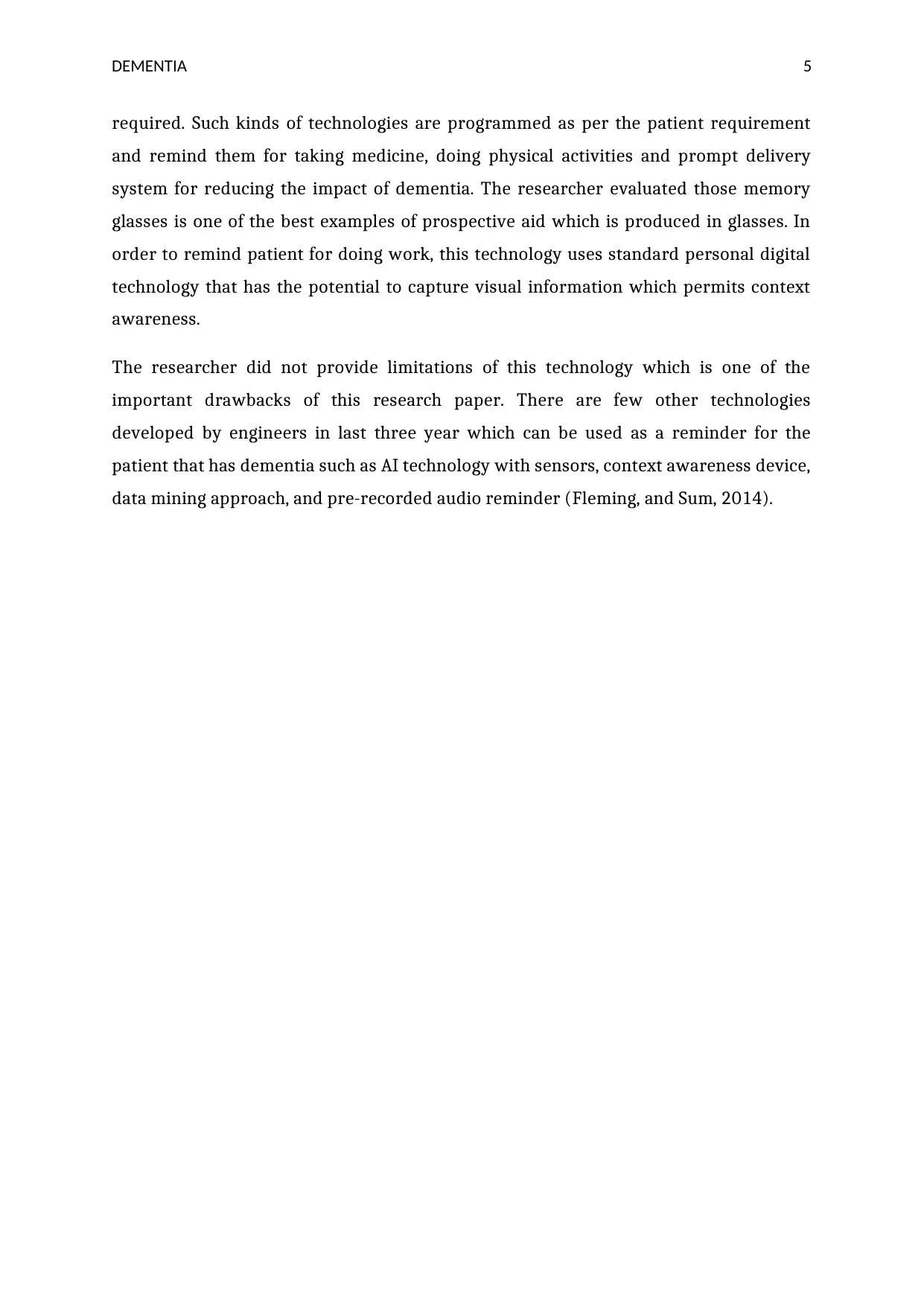
DEMENTIA 5
required. Such kinds of technologies are programmed as per the patient requirement
and remind them for taking medicine, doing physical activities and prompt delivery
system for reducing the impact of dementia. The researcher evaluated those memory
glasses is one of the best examples of prospective aid which is produced in glasses. In
order to remind patient for doing work, this technology uses standard personal digital
technology that has the potential to capture visual information which permits context
awareness.
The researcher did not provide limitations of this technology which is one of the
important drawbacks of this research paper. There are few other technologies
developed by engineers in last three year which can be used as a reminder for the
patient that has dementia such as AI technology with sensors, context awareness device,
data mining approach, and pre-recorded audio reminder (Fleming, and Sum, 2014).
required. Such kinds of technologies are programmed as per the patient requirement
and remind them for taking medicine, doing physical activities and prompt delivery
system for reducing the impact of dementia. The researcher evaluated those memory
glasses is one of the best examples of prospective aid which is produced in glasses. In
order to remind patient for doing work, this technology uses standard personal digital
technology that has the potential to capture visual information which permits context
awareness.
The researcher did not provide limitations of this technology which is one of the
important drawbacks of this research paper. There are few other technologies
developed by engineers in last three year which can be used as a reminder for the
patient that has dementia such as AI technology with sensors, context awareness device,
data mining approach, and pre-recorded audio reminder (Fleming, and Sum, 2014).
⊘ This is a preview!⊘
Do you want full access?
Subscribe today to unlock all pages.

Trusted by 1+ million students worldwide
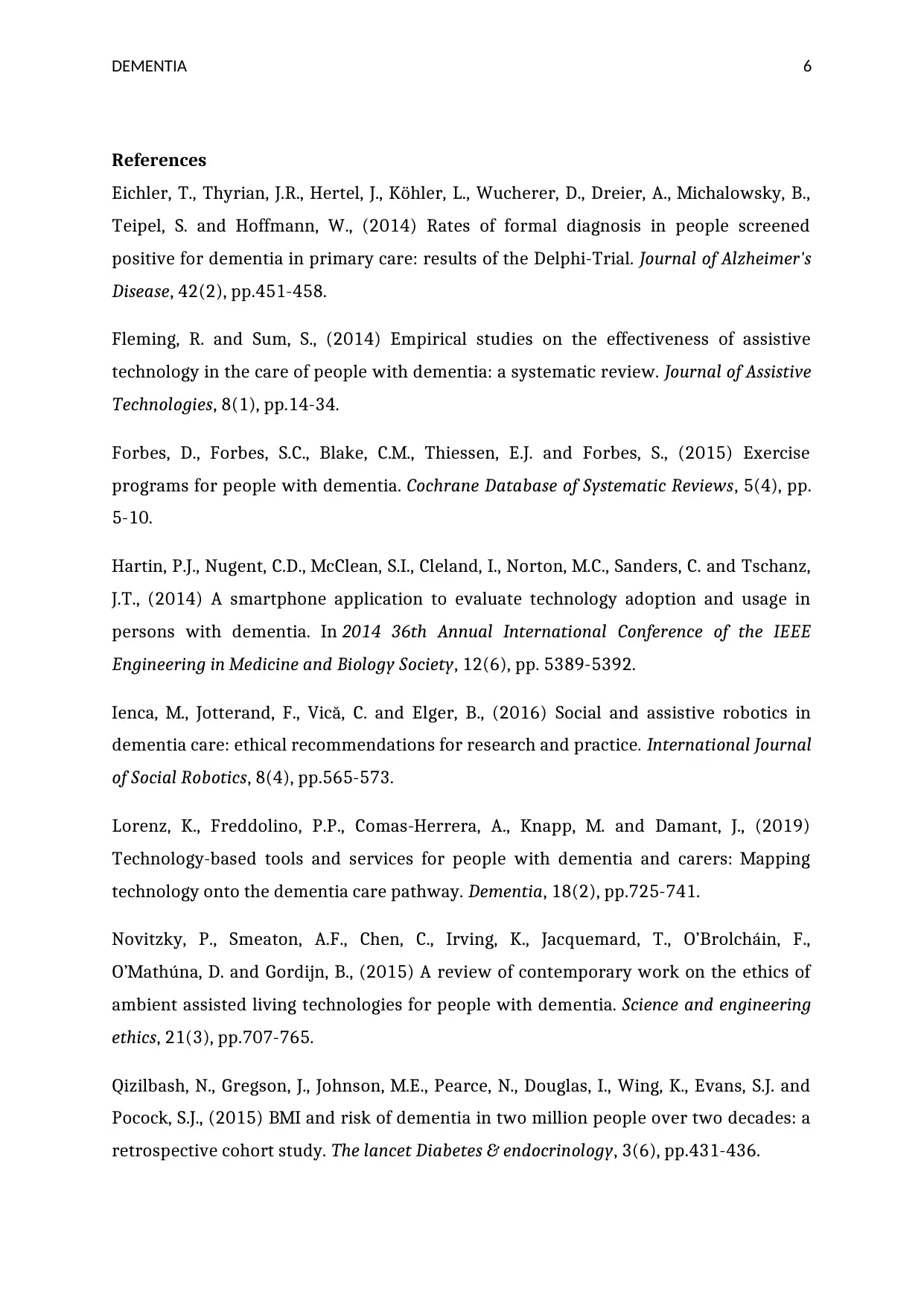
DEMENTIA 6
References
Eichler, T., Thyrian, J.R., Hertel, J., Köhler, L., Wucherer, D., Dreier, A., Michalowsky, B.,
Teipel, S. and Hoffmann, W., (2014) Rates of formal diagnosis in people screened
positive for dementia in primary care: results of the Delphi-Trial. Journal of Alzheimer's
Disease, 42(2), pp.451-458.
Fleming, R. and Sum, S., (2014) Empirical studies on the effectiveness of assistive
technology in the care of people with dementia: a systematic review. Journal of Assistive
Technologies, 8(1), pp.14-34.
Forbes, D., Forbes, S.C., Blake, C.M., Thiessen, E.J. and Forbes, S., (2015) Exercise
programs for people with dementia. Cochrane Database of Systematic Reviews, 5(4), pp.
5-10.
Hartin, P.J., Nugent, C.D., McClean, S.I., Cleland, I., Norton, M.C., Sanders, C. and Tschanz,
J.T., (2014) A smartphone application to evaluate technology adoption and usage in
persons with dementia. In 2014 36th Annual International Conference of the IEEE
Engineering in Medicine and Biology Society, 12(6), pp. 5389-5392.
Ienca, M., Jotterand, F., Vică, C. and Elger, B., (2016) Social and assistive robotics in
dementia care: ethical recommendations for research and practice. International Journal
of Social Robotics, 8(4), pp.565-573.
Lorenz, K., Freddolino, P.P., Comas-Herrera, A., Knapp, M. and Damant, J., (2019)
Technology-based tools and services for people with dementia and carers: Mapping
technology onto the dementia care pathway. Dementia, 18(2), pp.725-741.
Novitzky, P., Smeaton, A.F., Chen, C., Irving, K., Jacquemard, T., O’Brolcháin, F.,
O’Mathúna, D. and Gordijn, B., (2015) A review of contemporary work on the ethics of
ambient assisted living technologies for people with dementia. Science and engineering
ethics, 21(3), pp.707-765.
Qizilbash, N., Gregson, J., Johnson, M.E., Pearce, N., Douglas, I., Wing, K., Evans, S.J. and
Pocock, S.J., (2015) BMI and risk of dementia in two million people over two decades: a
retrospective cohort study. The lancet Diabetes & endocrinology, 3(6), pp.431-436.
References
Eichler, T., Thyrian, J.R., Hertel, J., Köhler, L., Wucherer, D., Dreier, A., Michalowsky, B.,
Teipel, S. and Hoffmann, W., (2014) Rates of formal diagnosis in people screened
positive for dementia in primary care: results of the Delphi-Trial. Journal of Alzheimer's
Disease, 42(2), pp.451-458.
Fleming, R. and Sum, S., (2014) Empirical studies on the effectiveness of assistive
technology in the care of people with dementia: a systematic review. Journal of Assistive
Technologies, 8(1), pp.14-34.
Forbes, D., Forbes, S.C., Blake, C.M., Thiessen, E.J. and Forbes, S., (2015) Exercise
programs for people with dementia. Cochrane Database of Systematic Reviews, 5(4), pp.
5-10.
Hartin, P.J., Nugent, C.D., McClean, S.I., Cleland, I., Norton, M.C., Sanders, C. and Tschanz,
J.T., (2014) A smartphone application to evaluate technology adoption and usage in
persons with dementia. In 2014 36th Annual International Conference of the IEEE
Engineering in Medicine and Biology Society, 12(6), pp. 5389-5392.
Ienca, M., Jotterand, F., Vică, C. and Elger, B., (2016) Social and assistive robotics in
dementia care: ethical recommendations for research and practice. International Journal
of Social Robotics, 8(4), pp.565-573.
Lorenz, K., Freddolino, P.P., Comas-Herrera, A., Knapp, M. and Damant, J., (2019)
Technology-based tools and services for people with dementia and carers: Mapping
technology onto the dementia care pathway. Dementia, 18(2), pp.725-741.
Novitzky, P., Smeaton, A.F., Chen, C., Irving, K., Jacquemard, T., O’Brolcháin, F.,
O’Mathúna, D. and Gordijn, B., (2015) A review of contemporary work on the ethics of
ambient assisted living technologies for people with dementia. Science and engineering
ethics, 21(3), pp.707-765.
Qizilbash, N., Gregson, J., Johnson, M.E., Pearce, N., Douglas, I., Wing, K., Evans, S.J. and
Pocock, S.J., (2015) BMI and risk of dementia in two million people over two decades: a
retrospective cohort study. The lancet Diabetes & endocrinology, 3(6), pp.431-436.
Paraphrase This Document
Need a fresh take? Get an instant paraphrase of this document with our AI Paraphraser
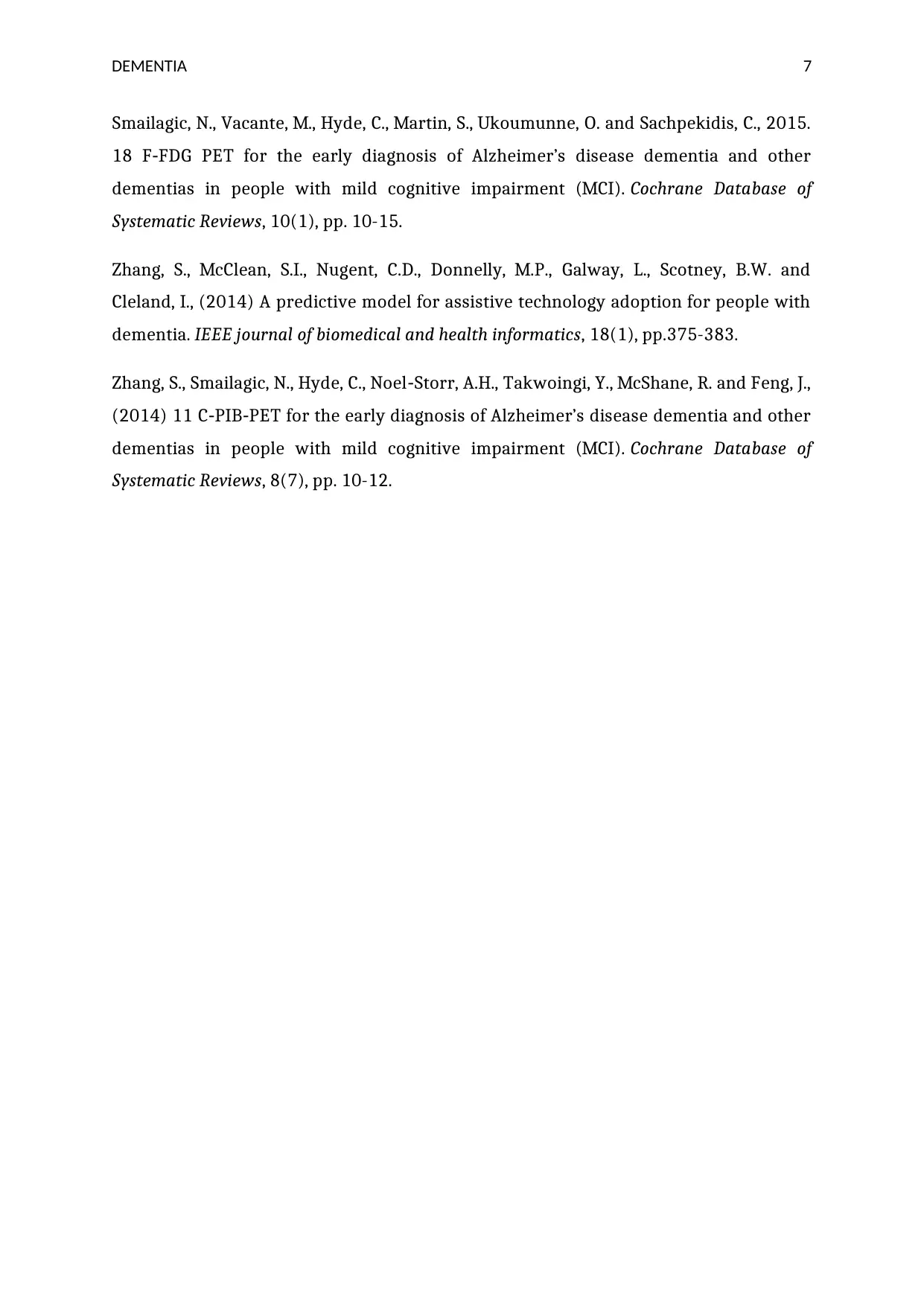
DEMENTIA 7
Smailagic, N., Vacante, M., Hyde, C., Martin, S., Ukoumunne, O. and Sachpekidis, C., 2015.
18 F‐FDG PET for the early diagnosis of Alzheimer’s disease dementia and other
dementias in people with mild cognitive impairment (MCI). Cochrane Database of
Systematic Reviews, 10(1), pp. 10-15.
Zhang, S., McClean, S.I., Nugent, C.D., Donnelly, M.P., Galway, L., Scotney, B.W. and
Cleland, I., (2014) A predictive model for assistive technology adoption for people with
dementia. IEEE journal of biomedical and health informatics, 18(1), pp.375-383.
Zhang, S., Smailagic, N., Hyde, C., Noel‐Storr, A.H., Takwoingi, Y., McShane, R. and Feng, J.,
(2014) 11 C‐PIB‐PET for the early diagnosis of Alzheimer’s disease dementia and other
dementias in people with mild cognitive impairment (MCI). Cochrane Database of
Systematic Reviews, 8(7), pp. 10-12.
Smailagic, N., Vacante, M., Hyde, C., Martin, S., Ukoumunne, O. and Sachpekidis, C., 2015.
18 F‐FDG PET for the early diagnosis of Alzheimer’s disease dementia and other
dementias in people with mild cognitive impairment (MCI). Cochrane Database of
Systematic Reviews, 10(1), pp. 10-15.
Zhang, S., McClean, S.I., Nugent, C.D., Donnelly, M.P., Galway, L., Scotney, B.W. and
Cleland, I., (2014) A predictive model for assistive technology adoption for people with
dementia. IEEE journal of biomedical and health informatics, 18(1), pp.375-383.
Zhang, S., Smailagic, N., Hyde, C., Noel‐Storr, A.H., Takwoingi, Y., McShane, R. and Feng, J.,
(2014) 11 C‐PIB‐PET for the early diagnosis of Alzheimer’s disease dementia and other
dementias in people with mild cognitive impairment (MCI). Cochrane Database of
Systematic Reviews, 8(7), pp. 10-12.
1 out of 8
Related Documents
Your All-in-One AI-Powered Toolkit for Academic Success.
+13062052269
info@desklib.com
Available 24*7 on WhatsApp / Email
![[object Object]](/_next/static/media/star-bottom.7253800d.svg)
Unlock your academic potential
Copyright © 2020–2025 A2Z Services. All Rights Reserved. Developed and managed by ZUCOL.




